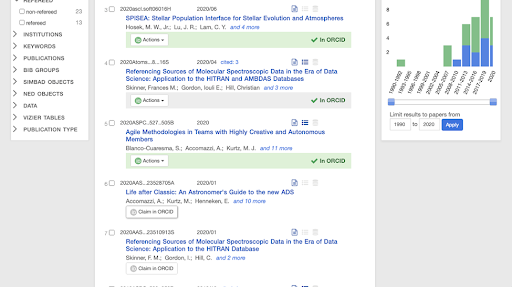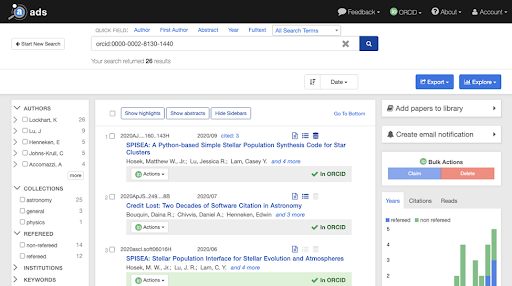The Center for Astrophysics, based at Harvard University and run jointly by it and the Smithsonian Astrophysical Observatory (SAO), a member of the ORCID US Community, has integrated ORCID with their NASA Astrophysics Data System (NASA ADS) database. NASA ADS is an index database for astronomy literature which provides access to roughly 16 million records including data archives, journal articles, and open access articles. The NASA ADS integration with ORCID has a long history starting from 2014/2015 with funding from the American Astronomical Society (AAS). This integration is being continually developed and improved to its current iteration.
This blog post is based on a presentation by Kelly Lockhart, Software Engineer at NASA Astrophysics Data System (Center for Astrophysics | Harvard & Smithsonian), at the ORCID US Community Showcase Webinar #6 on April 27, 2021. Many thanks to Kelly for sharing the NASA ADS case study!
NASA ADS and ORCID Integration
The NASA ADS ORCID integration serves two functions: 1) Searching and claiming of papers by Name; and 2) Searching and claiming of papers by ORCID ID. The claiming by name function of NASA ADS provides a way for authors to update their ORCID record with what is available in the database using their name to search. Users of the database can search for their name and the system then pulls papers that match that name. They can then toggle or turn-on ORCID mode (see Figure 1). ORCID mode provides information on whether the paper is already in the author’s ORCID or not. If not, authors can claim the paper and that data will be pushed to ORCID (see Figure 2). Once claimed, ORCID will be updated with the claimed paper, and ORCID status in NASA ADS will reflect an “In ORCID'' status.

Figure 1: NASA ADS with ORCID mode functionality.

Figure 2: Search results with unclaimed papers.
The second functionality of the NASA ADS integration is the searching and claiming of papers using the ORCID iD (see Figure 3). This functionality provides an option for authors to search beyond their known-name convention as it captures other papers published using other name formations, such as using initials or a previous name instead of their full or current name. An individual’s ORCID iD stays the same over time despite any changes or variations in name, so ORCID iD serves as the identifier that pulls these papers.

Figure 3: Search results using ORCID iD search method.
The ORCID integration in NASA ADS also goes beyond the pulling in and pushing out of data. NASA ADS also validates papers to make sure that the results are papers belonging to the author searching and claiming the paper in the database. The system identifies authors who recently claimed papers and their ORCID iD is used to validate their claim as well as pull in additional papers from their ORCID profile that match their name and alternative names. In addition, publishers also send metadata to NASA ADS sometimes containing ORCID iDs. Essentially, the search results are the validated papers as well as papers with data provided by publishers. With that, NASA ADS is composed of roughly 1.3 million records with validated ORCID iDs.
Future of NASA ADS and ORCID
NASA ADS plans to make it easier for users to search the index. In particular, if a user is searching for a specific researcher, there is no way for them to know the ORCID iD of the researcher from within the database. Users would have to grab the ORCID iD information from somewhere else. So, NASA ADS plans to incorporate the discovery of a researcher or author’s ORCID iD within the database. Furthermore, they are planning to streamline the claiming process by providing more options to the authors such as suggesting new papers to add to the index and allowing authors to “flag” search results that do not belong to them with a “not me” tag indicating that the entry is not their paper or publication.
